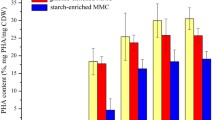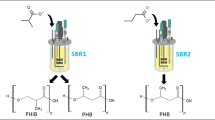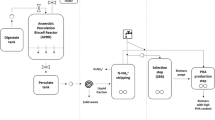Abstract
Polyhydroxyalkanoates (PHAs) are promising alternatives to plastics since they have similar properties to polyolefin but are biodegradable and biocompatible. Recently, the conversion of propionate wastewater to PHAs by undefined mixed microbial cultures becomes attractive. However, how microbial community changes remains unclear during the enrichment step, which is critical for a robust PHA-producing system. In this study, PHA-accumulating cultures were enriched under feast/famine condition using propionate-rich substrates. Our results showed that during the first 2 h of the enrichment, dissolved oxygen of cultures increased remarkably until saturation, and amounts of C, N, and chemical oxygen demand of cultures decreased significantly to a very low level. High-throughput sequencing revealed that bacterial populations affiliated with Alphaproteobacteria and Bacteroidetes dominated the cultures enriched. Most of these dominant populations contributed to the conversion of short-chain fatty acids to PHAs. Being fed with the substrate rich in propionate but without nitrogen, the cultures enriched could accumulate nearly 27% PHAs at 72 h with higher content of hydroxyvalerate. Our work reveals the process in which environmental microbes responded to propionate-rich condition and shifted to populations for accumulating PHAs; it also will be helpful to develop an efficient PHA-producing system using propionate-rich waste.





Similar content being viewed by others
References
Gao, X., Chen, J. C., Wu, Q., & Chen, G. Q. (2011). Polyhydroxyalkanoates as a source of chemicals, polymers, and biofuels. Current Opinion in Biotechnology, 22, 768–774.
Andreessen, B., Taylor, N., & Steinbuchel, A. (2014). Poly(3-hydroxypropionate): a promising alternative to fossil fuel-based materials. Applied and Environmental Microbiology, 80, 6574–6582.
Kleerebezem, R., & van Loosdrecht, M. C. (2007). Mixed culture biotechnology for bioenergy production. Current Opinion in Biotechnology, 18, 207–212.
Reis, M. A., Serafim, L. S., Lemos, P. C., Ramos, A. M., Aguiar, F. R., & Van Loosdrecht, M. C. (2003). Production of polyhydroxyalkanoates by mixed microbial cultures. Bioprocess and Biosystems Engineering, 25, 377–385.
Rossi, F., Olguin, E. J., Diels, L., & De Philippis, R. (2015). Microbial fixation of CO2 in water bodies and in drylands to combat climate change, soil loss and desertification. New Biotechnology, 32, 109–120.
Valentino, F., Morgan-Sagastume, F., Fraraccio, S., Corsi, G., Zanaroli, G., Werker, A., & Majone, M. (2015). Sludge minimization in municipal wastewater treatment by polyhydroxyalkanoate (PHA) production. Environmental Science and Pollution Research International, 22, 7281–7294.
Morgan-Sagastume, F., Hjort, M., Cirne, D., Gerardin, F., Lacroix, S., Gaval, G., Karabegovic, L., Alexandersson, T., Johansson, P., Karlsson, A., Bengtsson, S., Arcos-Hernandez, M. V., Magnusson, P., & Werker, A. (2015). Integrated production of polyhydroxyalkanoates (PHAs) with municipal wastewater and sludge treatment at pilot scale. Bioresource Technology, 181, 78–89.
Anterrieu, S., Quadri, L., Geurkink, B., Dinkla, I., Bengtsson, S., Arcos-Hernandez, M., Alexandersson, T., Morgan-Sagastume, F., Karlsson, A., Hjort, M., Karabegovic, L., Magnusson, P., Johansson, P., Christensson, M., & Werker, A. (2014). Integration of biopolymer production with process water treatment at a sugar factory. New Biotechnology, 31, 308–323.
Carvalheira, M., Oehmen, A., Carvalho, G., & Reis, M. A. (2014). Survival strategies of polyphosphate accumulating organisms and glycogen accumulating organisms under conditions of low organic loading. Bioresource Technology, 172, 290–296.
Nikodinovic-Runic, J., Guzik, M., Kenny, S. T., Babu, R., Werker, A., & KE, O. C. (2013). Carbon-rich wastes as feedstocks for biodegradable polymer (polyhydroxyalkanoate) production using bacteria. Advances in Applied Microbiology, 84, 139–200.
McQualter, R. B., Petrasovits, L. A., Gebbie, L. K., Schweitzer, D., Blackman, D. M., Chrysanthopoulos, P., Hodson, M. P., Plan, M. R., Riches, J. D., Snell, K. D., Brumbley, S. M., & Nielsen, L. K. (2015). The use of an acetoacetyl-CoA synthase in place of a beta-ketothiolase enhances poly-3-hydroxybutyrate production in sugarcane mesophyll cells. Plant Biotechnology Journal, 13, 700–707.
Tan, D., Wu, Q., Chen, J. C., & Chen, G. Q. (2014). Engineering Halomonas TD01 for the low-cost production of polyhydroxyalkanoates. Metabolic Engineering, 26C, 34–47.
Albuquerque, M. G., Martino, V., Pollet, E., Averous, L., & Reis, M. A. (2011). Mixed culture polyhydroxyalkanoate (PHA) production from volatile fatty acid (VFA)-rich streams: effect of substrate composition and feeding regime on PHA productivity, composition and properties. Journal of Biotechnology, 151, 66–76.
Carvalheira, M., Oehmen, A., Carvalho, G., & Reis, M. A. (2014). The effect of substrate competition on the metabolism of polyphosphate accumulating organisms (PAOs). Water Research, 64, 149–159.
Johnson, K., Kleerebezem, R., & van Loosdrecht, M. C. (2010). Influence of the C/N ratio on the performance of polyhydroxybutyrate (PHB) producing sequencing batch reactors at short SRTs. Water Research, 44, 2141–2152.
Jiang, Y., & Chen, Y. (2009). The effects of the ratio of propionate to acetate on the transformation and composition of polyhydroxyalkanoates with enriched cultures of glycogen-accumulating organisms. Environmental Technology, 30, 241–249.
Liu, C., Wang, H., Xing, W., & Wei, L. (2013). Composition diversity and nutrition conditions for accumulation of polyhydroxyalkanoate (PHA) in a bacterial community from activated sludge. Applied Microbiology and Biotechnology, 97, 9377–9387.
Fradinho, J. C., Oehmen, A., & Reis, M. A. (2013). Effect of dark/light periods on the polyhydroxyalkanoate production of a photosynthetic mixed culture. Bioresource Technology, 148, 474–479.
Albuquerque, M. G., Carvalho, G., Kragelund, C., Silva, A. F., Barreto Crespo, M. T., Reis, M. A., & Nielsen, P. H. (2013). Link between microbial composition and carbon substrate-uptake preferences in a PHA-storing community. The ISME Journal, 7, 1–12.
Albuquerque, M. G., Eiroa, M., Torres, C., Nunes, B. R., & Reis, M. A. (2007). Strategies for the development of a side stream process for polyhydroxyalkanoate (PHA) production from sugar cane molasses. Journal of Biotechnology, 130, 411–421.
Johnson, K., Jiang, Y., Kleerebezem, R., Muyzer, G., & van Loosdrecht, M. (2009). Enrichment of a mixed bacterial culture with a high polyhydroxyalkanoate storage capacity. Biomacromolecules, 10, 670–676.
Quast, C., Pruesse, E., Yilmaz, P., Gerken, J., Schweer, T., Yarza, P., Peplies, J., & Glöckner, F. (2013). The SILVA ribosomal RNA gene database project: improved data processing and web-based tools. Nucl Acids Res, 41, D590–D596.
Tamura, K., Stecher, G., Peterson, D., Filipski, A., & Kumar, S. (2013). MEGA6: molecular evolutionary genetics analysis version 6.0. Molecular Biology and Evolution, 30, 2725–2729.
Tamura, K., Nei, M., & Kumar, S. (2004). Prospects for inferring very large phylogenies by using the neighbor-joining method. Proceedings of the National Academy of Sciences of the United States of America, 101, 11030–11035.
Tian, Z., Zhang, Y., Li, Y., Chi, Y., & Yang, M. (2015). Rapid establishment of thermophilic anaerobic microbial community during the one-step startup of thermophilic anaerobic digestion from a mesophilic digester. Water Research, 69, 9–19.
Rice, E., Baird, R., Eaton, A., & Cleseri, L. (Eds.) (1998). Standard methods for the examination of water and wastewater. Washington, DC: American Public Health Association, American Water Works Association, and Water Environmental Federation.
Oehmen, A., Keller-Lehmann, B., Zeng, R. J., Yuan, Z., & Keller, J. (2005). Optimisation of poly-β-hydroxyalkanoate analysis using gas chromatography for enhanced biological phosphorus removal systems. Journal of Chromatography A, 1070, 131–136.
Albuquerque, M. G., Concas, S., Bengtsson, S., & Reis, M. A. (2010). Mixed culture polyhydroxyalkanoates production from sugar molasses: the use of a 2-stage CSTR system for culture selection. Bioresource Technology, 101, 7123–7133.
Kranz, R. G., Gabbert, K. K., & Madigan, M. T. (1997). Positive selection systems for discovery of novel polyester biosynthesis genes based on fatty acid detoxification. Applied and Environmental Microbiology, 63, 3010–3013.
Kranz, R. G., Gabbert, K. K., Locke, T. A., & Madigan, M. T. (1997). Polyhydroxyalkanoate production in Rhodobacter capsulatus: genes, mutants, expression, and physiology. Applied and Environmental Microbiology, 63, 3003–3009.
Pardelha, F., Albuquerque, M. G., Carvalho, G., Reis, M. A., Dias, J. M., & Oliveira, R. (2013). Segregated flux balance analysis constrained by population structure/function data: the case of PHA production by mixed microbial cultures. Biotechnology and Bioengineering, 110, 2267–2276.
Lemos, P. C., Levantesi, C., Serafim, L. S., Rossetti, S., Reis, M. A. M., & Tandoi, V. (2008). Microbial characterisation of polyhydroxyalkanoates storing populations selected under different operating conditions using a cell-sorting RT-PCR approach. Applied Microbiology and Biotechnology, 78, 351–360.
Salgaonkar, B. B., & Braganca, J. M. (2015). Biosynthesis of poly(3-hydroxybutyrate-co-3-hydroxyvalerate) by Halogeometricum borinquense strain E3. International Journal of Biological Macromolecules, 78, 339–346.
Samori, C., Abbondanzi, F., Galletti, P., Giorgini, L., Mazzocchetti, L., Torri, C., & Tagliavini, E. (2015). Extraction of polyhydroxyalkanoates from mixed microbial cultures: impact on polymer quality and recovery. Bioresource Technology, 189, 195–202.
Amulya, K., Jukuri, S., & Venkata Mohan, S. (2015). Sustainable multistage process for enhanced productivity of bioplastics from waste remediation through aerobic dynamic feeding strategy: process integration for up-scaling. Bioresource Technology, 188, 231–239.
Foong, C. P., Lau, N. S., Deguchi, S., Toyofuku, T., Taylor, T. D., Sudesh, K., & Matsui, M. (2014). Whole genome amplification approach reveals novel polyhydroxyalkanoate synthases (PhaCs) from Japan Trench and Nankai Trough seawater. BMC Microbiology, 14, 318.
Meng, D. C., Wang, Y., Wu, L. P., Shen, R., Chen, J. C., Wu, Q., & Chen, G. Q. (2015). Production of poly(3-hydroxypropionate) and poly(3-hydroxybutyrate-co-3-hydroxypropionate) from glucose by engineering Escherichia coli. Metabolic Engineering, 29, 189–195.
Liu, K., Chen, Y., Xiao, N., Zheng, X., & Li, M. (2015). Effect of humic acids with different characteristics on fermentative short-chain fatty acids production from waste activated sludge. Environmental Science & Technology, 49, 4929–4936.
Werner, J. J., Knights, D., Garcia, M. L., Scalfone, N. B., Smith, S., Yarasheski, K., Cummings, T. A., Beers, A. R., Knight, R., & Angenent, L. T. (2011). Bacterial community structures are unique and resilient in full-scale bioenergy systems. Proceedings of the National Academy of Sciences of the United States of America, 108, 4158–4163.
Fernandez-Dacosta, C., Posada, J. A., Kleerebezem, R., Cuellar, M. C., & Ramirez, A. (2015). Microbial community-based polyhydroxyalkanoates (PHAs) production from wastewater: techno-economic analysis and ex-ante environmental assessment. Bioresource Technology, 185, 368–377.
dos Santos, L. A., Ferreira, V., Neto, M. M., Pereira, M. A., Mota, M., & Nicolau, A. (2015). Study of 16 Portuguese activated sludge systems based on filamentous bacteria populations and their relationships with environmental parameters. Applied Microbiology and Biotechnology, 99, 5307–5316.
Wang, Y., Zhang, C., Gong, T., Zuo, Z., Zhao, F., Fan, X., Yang, C., & Song, C. (2015). An upp-based markerless gene replacement method for genome reduction and metabolic pathway engineering in Pseudomonas mendocina NK-01 and Pseudomonas putida KT2440. Journal of Microbiological Methods, 113, 27–33.
Acknowledgements
This work was supported by the Sichuan Key Technology R&D Program (2014NZ0045), Special Fund for Agro-scientific Research in the Public Interest of China (201403019), and Youth Science and Technology Foundation of Sichuan Province (2015JQO047).
Author information
Authors and Affiliations
Corresponding author
Ethics declarations
Conflict of Interest
The authors declare that they have no conflict of interest.
Electronic supplementary material
ESM 1
(DOC 2487 kb)
Rights and permissions
About this article
Cite this article
Wu, B., Zheng, D., Zhou, Z. et al. The Enrichment of Microbial Community for Accumulating Polyhydroxyalkanoates Using Propionate-Rich Waste. Appl Biochem Biotechnol 182, 755–768 (2017). https://doi.org/10.1007/s12010-016-2359-2
Received:
Accepted:
Published:
Issue Date:
DOI: https://doi.org/10.1007/s12010-016-2359-2




